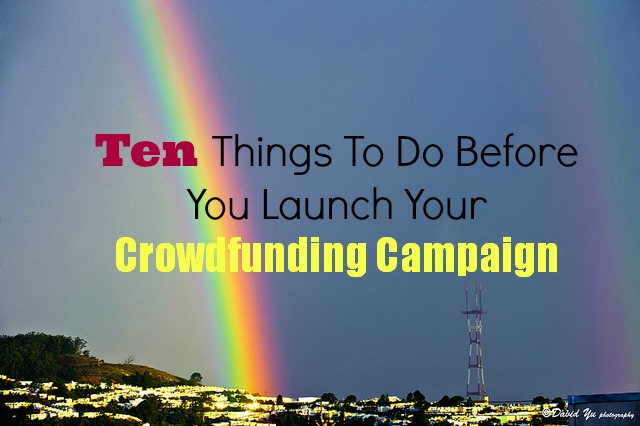Crowdfunding is becoming an increasingly popular method to raise finance for creative business projects. Of course, it has other advantages too – from testing the market, growing brand awareness and gaining free press coverage.
The key to success is often in the preparation and this is even more true of crowdfunding campaigns. Your campaign needs to be ready to rock the second it goes live. It is worth preparing for your crowdfunding campaign the second you get the idea. Most of the preparation will stand you in good stead for promoting your product as you will continue to use it long after the crowdfunding campaign is over. The more you can achieve of the following list, the higher the chance for success in your crowdfunding efforts. Asking people for money and getting it from them is easier said than done, no matter how passionate you are about your project and how many people you may know.
56% of Kickstarter and 27% of Fundit campaigns fail. There are also a percentage that do not get any pledges. People will not throw money at you, you have to work for it. During my crowdfunding campaign last summer, it felt like I had a second full-time job but every second is worth it – not just for the finance but for the self-belief and confidence you gain too – yes, it almost feel like you have won an election when you succeed.
#1. Build an Email List – If you are already in business, you should have a newsletter email list (and if you don’t, it is never too late to start). Encourage your blog readers and facebook followers to subscribe to your email list and reward them with a monthly newsletter filled with valuable content – be it of information they appreciate, useful tips, quality content or discount vouchers. As they are accustomed to receiving quality newsletters from you, they will be more inclined to read and click the link when you send them a request to pledge in your campaign. When you launch the campaign, include a link to it in your email signature so everyone you email has a chance to see it.
#2. Friends and Family – Getting early pledgers is crucial in a crowdfunding campaign. Potential pledgers who do not know you will be suspicious of the quality of your product if they see there aren’t many pledgers in the early days – this is where friends and family come in. Therefore, check you have email addresses for as many of them as possible (it is better to email them rather than telephone them so they are online and have to only make one click to reach your campaign) and email them before it goes live, informing them about your forthcoming project and why it is so important to you. Email them again once it goes live, asking them to pledge. It is also worthwhile emailing those that haven’t pledged a third time, either during the ‘natural lull’ in the middle or a few days before the end so they help with the final surge.
#3. Your Blog – a blog is where you can converse with your readers, your followers, your potential buyers of your product and your future pledgers. You can tell them about your project, encourage them to give you feedback and become part of your journey. Once the crowdfunding campaign starts, you can write a weekly post on its progress, thereby growing more interest.
#4. Social Media – You need to grow your followers on the various social media platforms and that means taking the time to have conversations with people who think may be interested in your future product – natural, interesting, engaging conversations. Twitter is particularly important as it makes key influencers and celebrities more accessible. Some creators start a twitter account specifically for the crowdfunding campaign but remember you will most likely want to use it in the run up to your product launch too.
#5. The 4 W’s and the H – You will need to answer the who, what, where, when and how in your crowdfunding pitch so outline them well in advance.
What – What is the project? What will it offer? What rewards are you offering in return for pledges?
Who – Who is involved? Show your personality and your passion for this project. Ensure your profile reads well and answers all potential questions. Don’t forget to create a sense of fun too – make the whole project a joy for everyone to be involved in. Who will help you? Even if you are doing it all on your won, you will need someone to bounce ideas off of, and if nothing else, you need someone to keep encouraging you and tell you to keep going on those days you feel deflated so select someone who is optimistic, trustworthy and social media or PR savvy if you can.
When – When will it happen? When will the product be launched? When will the various rewards be available to the pledgers?
Where – Where (which country) are you based in? Are the rewards available to pledgers from various countries? Is there an extra cost in the delivery of rewards to those abroad?
How – How passionate are you about this project? How can you ensure it will be a success? How have similar campaigns to yours succeeded – what did they do well? How did similar campaigns to yours fail – what did they do wrong? How can you persuade people to want it to succeed? How are you going to deliver those rewards? How much money do you need? How long will your campaign be for? Those lasting a month seem to be the most popular and the most successful.
#6. Video – Campaigns with video are reputed to be more successful and raise more funds than campaigns without a video. Photographs can only show so much. A video gives potential pledgers a few minutes to decide if they like your personality, if they admire your enthusiasm, if they can share your passion, if they believe in you. Ideally, the video should be shot in an appropriate setting for the project e.g. At a photographic exhibition or your dark room if you are planning a photographic project, in a kitchen if you are planning a cookbook, in an allotment if you are looking for funds for community gardens …. Plan and prepare your video carefully as it is one of the most crucial aspects to your project’s success.
#7. Your Project – Prepare your project as much as you can so you can showcase it. Give potential pledgers a ‘sneak peek’ into it – they need to be able to believe in it. If it is a book, share extracts / illustrations / front cover with readers. If it is a cookbook, share a recipe or point to the success of a previous book or your blog. If it is for a film, your video should showcase the quality of your film-making skills.
#8. Rewards – What rewards are you going to offer? What might your potential pledgers like? Remember you need to provide rewards at a variety of different price points. The €40 / £40 / $50 is often the most popular but you also need to have rewards at $5, $20, $100 and of course, if you can offer rewards at high price points which will really help you to reach your target, then do so. Many creators offer a private concert or private dinner at €1000 or more – you are trying to think of rewards that won’t cost you a huge amount of money but the pledgers will see value in them as they can’t be bought otherwise. Some platforms (e.g Kickstarter) lets you add in extra rewards during the campaign which is handy as you can respond to what is working well and what isn’t. Some (e.g. Fundit) don’t let you do this so good preparation is key to success.
#9. Costings – Now you have come up with your rewards, you need to double check the cost of getting them to the pledgers. Doublecheck the postage because it can work out more expensive than you might think. Don’t just create it for your own country but think worldwide. Some US creators ask pledgers to add $5 to the pledge if living outside the US.
#10. Prepare for Overwhelming Success – It’s not often it happens but it just might – that your product captures the public imagination and you receive an incredible amount of free press coverage and instead of receiving the $10,000 you were looking for – it is edging up towards $50,000 and more as some of your rewards are just snapped up. That’s fine if people want the product when it is finished but what if they want a reward that is going to take you significant time and money to create and send out? In one way, this is absolutely wonderful but the danger is that you end up having to spend too much time on getting some rewards out within a defined time rather than concentrating on your actual product.
Good luck! If you have any questions do ask them in the comments below. I’d’ also love to hear what you think of my post. Stay tuned for my next post which will highlight what you need to do during your crowdfunding campaign to maximise your chances of success.
photo credit: davidyuweb via photopin cc










Pingback: Running A Crowdfunding Project For Your Pets
Pingback: Running A Crowdfunding Project For Your Pets | Pet Sitters Ireland | Pet Sitting | Dog Walking | Pet Shop Online
Pingback: Crowdfunding Must-Dos, Blogging Tips, Twitter Lessons, Social Advertising … It’s the We Teach Social round up